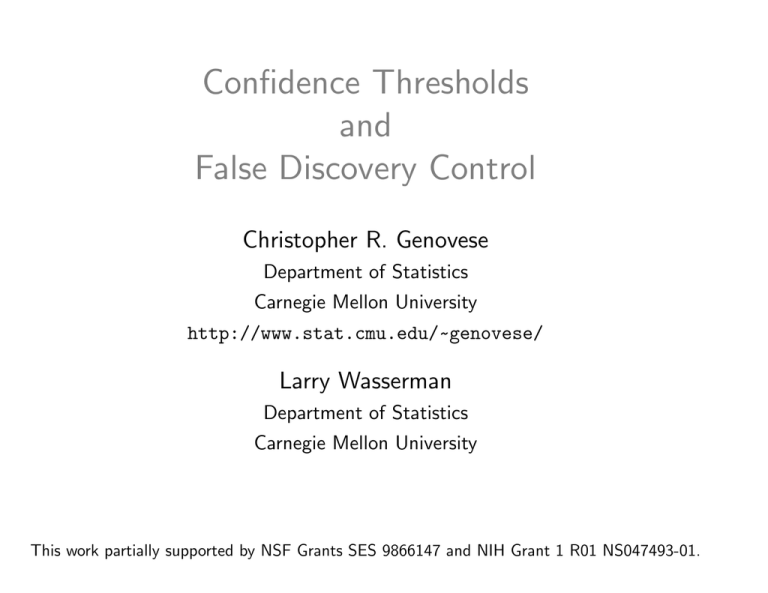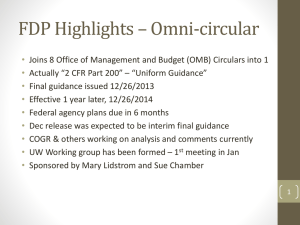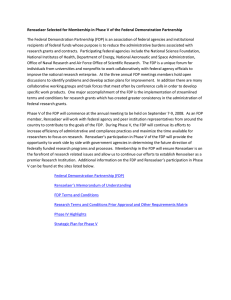Talk 2 - CMU Statistics - Carnegie Mellon University
advertisement

Confidence Thresholds
and
False Discovery Control
Christopher R. Genovese
Department of Statistics
Carnegie Mellon University
http://www.stat.cmu.edu/~genovese/
Larry Wasserman
Department of Statistics
Carnegie Mellon University
This work partially supported by NSF Grants SES 9866147 and NIH Grant 1 R01 NS047493-01.
Motivating Example #1: fMRI
1850
1900
1950
2000
• fMRI Data: Time series of 3-d images acquired while subject
performs specified tasks.
Task
0
Control
24
48
Task
Control
72
96
Task
Control
120
144
Task Control
168
• Goal: Characterize task-related signal changes caused (indirectly)
by neural activity. [See, for example, Genovese (2000), JASA 95, 691.]
fMRI (cont’d)
Perform hypothesis tests at
many thousands of volume
elements to identify loci of
activation.
Motivating Example #2: Cosmology
• Baryon wiggles (Miller, Nichol, Batuski 2001)
• Radio Source Detection (Hopkins et al. 2002)
• Dark Energy (Scranton et al. 2003)
2
z ~ 0.57
z ~ 0.49
z ~ 0.43
z ~ 0.35
1.5
wgT(θ) [µK]
1
0.5
0
-0.5
1.5
1
0.5
0
-0.5
-1
1
10
θ (degrees)
1
10
Motivating Example #3: DNA Microarrays
• New technologies allow measurement of gene expression for
thousands of genes simultaneously.
Gene
1
2
3
4
5
6
..
1
X111
X211
..
Subject
2
3
X121
X131
X221
X231
..
..
Condition 1
...
...
...
...
1
X112
X212
..
Subject
2
3
X122
X132
X222
X232
..
..
...
...
...
...
Condition 2
• Goal: Identify genes associated with differences among conditions.
• Typical analysis: hypothesis test at each gene.
Objective
Develop methods for exceedance control of the
False Discovery Proportion (FDP):
(
False Discoveries
>γ
P
Discoveries
)
≤α
for 0 < α, γ < 1,
as an alternative to mean (FDR) control.
Useful in applications as the basis for a secondary inference
about the pattern of false discoveries.
Also useful as an FDR diagnostic.
Plan
1. Set Up
– Testing Framework
– FDR and FDP
2. Exceedance Control for FDP
– Inversion and the P(k) test
– Power and Optimality
– Combining P(k) tests
– Augmentation
3. False Discovery Control for Random Fields
– Confidence Supersets and Thresholds
– Controlling the Proportion of False Clusters
– Scan Statistics
Plan
1. Set Up
– Testing Framework
– FDR and FDP
2. Exceedance Control for FDP
– Inversion and the P(k) test
– Power and Optimality
– Combining P(k) tests
– Augmentation
3. False Discovery Control for Random Fields
– Confidence Supersets and Thresholds
– Controlling the Proportion of False Clusters
– Scan Statistics
The Multiple Testing Problem
• Perform m simultaneous hypothesis tests with a common procedure.
• For any given procedure, classify the results as follows:
H0 True
H0 False
Total
H0 Retained
H0 Rejected
Total
TN
FN
FD
TD
T0
T1
N
D
m
Mnemonics: T/F = True/False, D/N = Discovery/Nondiscovery
All quantities except m, D, and N are unobserved.
• The problem is to choose a procedure that balances the
competing demands of sensitivity and specificity.
Testing Framework: Hypotheses
Let random vectors X1, . . . , Xn be drawn iid from distribution P.
Consider m hypotheses (typically m >> n) of the form
H0j : P ∈ Mj
versus
H1j : P 6∈ Mj
j = 1, . . . , m,
for sets of probability distributions M1, . . . , Mm.
Common case:
Xi = (Xi1, . . . , Xim) comprises m measurements on subject i.
Here, we might take Mj = P: EP(Xij ) = µj for some constant µj .
Testing Framework: P-values
Define the following:
n
o
• Hypothesis indicators H m = (H1, . . . , Hm) with Hj = 1 P 6∈ Mj .
• Set of true nulls S0 ≡ S0(P) = {j ∈ S: Hj = 0} where
S = {1, . . . , m}.
• Test statistics Zj = Zj (X1, . . . , Xn) for H0j , for each j ∈ S.
• P-values P m = (P1, . . . , Pm). Let PW = (Pi: i ∈ W ⊂ S).
• Ordered p-values P(1) < · · · < P(m).
Assume Pj | Hj = 0 ∼ Unif(0, 1).
Initially assume that the Pj s are independent, but
will weaken this later.
Testing Framework: Rejection Sets
We call a rejection set any R = R(P m) ⊂ S that
indexes the rejected null hypotheses H0j .
n
In practice, R will usually be of the form j ∈ S: Pj ≤ T
for a random threshold T = T (P m).
o
Want to define rejection sets that control specified error criteria.
Example: say that R controls k-familywise error at level α if
n
o
P #(R ∩ S0(P)) > k ≤ α,
where #(B) denotes the number of points in a set B.
The False Discovery Proportion
Define the false discovery proportion (FDP) for each rejection set R
by
n
o
Pm
false rejections
j=1(1 − Hj )1 R 3 j
n
o
=
Γ(R) ≡ FDP(R) =
Pm
rejections
j=1 1 R 3 j
where the ratio is defined to be zero if the denominator is zero.
The false discovery rate FDR(R) is defined by
FDR(R) = E(Γ(R)).
If R is defined by a threshold T , write Γ(T ) interchangeably, with Γ(t)
corresponding to a fixed threshold t.
Specifying the function t 7→ Γ(t) is sufficient to determine the entire envelope for
rejection sets defined by a threshold.
Plan
1. Set Up
– Testing Framework
– FDR and FDP
2. Exceedance Control for FDP
– Inversion and the P(k) test
– Power and Optimality
– Combining P(k) tests
– Augmentation
3. False Discovery Control for Random Fields
– Confidence Supersets and Thresholds
– Controlling the Proportion of False Clusters
– Scan Statistics
Confidence Envelopes and Exceedance Control
Goal: find a rejection set R such that
n
o
P Γ(R) > γ ≤ α
for specified 0 < α, γ < 1. We call such an R a (γ, α) rejection set.
Our main tool for finding these are confidence envelopes.
A 1 − α confidence envelope for FDP is a random function
Γ(C) = Γ(C; P1, . . . , Pm) such that
n
o
P Γ(C) ≥ Γ(C), for all C ≥ 1 − α.
Confidence Envelopes and Thresholds
It’s easiest to visualize a 1 − α confidence envelope for FDP
as a random function FDP(t) on [0, 1] such that
n
o
P FDP(t) ≤ FDP(t) for all t ≥ 1 − α.
Given such an envelope, we can construct “confidence thresholds.”
Two special cases have proven useful:
– Fixed-ceiling: T = sup{t: FDP(t) ≤ α}.
FDP
– Minimum-envelope: T = sup{t: FDP(t) = mint FDP(t)}.
t
Inversion Construction: Main Idea
Construct confidence envelope by inverting a set of uniformity tests.
Specifically, consider all subsets of the p-values that cannot be
distinguished from a sample of Uniforms by a suitable level α test.
Allow each of these subsets as one configuration of true nulls.
Maximize FDP pointwise over these configurations.
Inversion Construction: Step 1
For every W ⊂ S, test at level α the hypothesis that
PW = (Pi: i ∈ W )
is a sample from a Uniform(0, 1) distribution:
H0 : W ⊂ S 0
versus H1 : W 6⊂ S0.
Formally, let Ψ = {ψW : W ⊂ S} be a set of non-randomized tests
such that
n
o
P ψW (U1, . . . , U#(W )) = 1 ≤ α
whenever U1, . . . , U#(W ) ← Uniform(0, 1).
Inversion Construction: Step 2
Let U denote the collection of all subsets W not rejected in the
previous step:
U = {W : ψW (PW ) = 0}.
Now define
max #(B
Γ(C) = B∈U
∩ C)
#(C)
0
If U is closed under unions, then
if C 6= ∅,
otherwise.
#(U ∩ C)
Γ(C) =
#(C)
where U = ∪ {V : V ∈ U }. This is a confidence superset for S0:
n
P S0 ⊂ U
o
≥ 1 − α.
Inversion Construction: Step 3
Choose R = R(P1, . . . , Pm) as large as possible such that
Γ(R) ≤ γ.
n
o
(Typically, take R of the form R = j: Pj ≤ T where
the confidence threshold T = sup{t : Γ(t) ≤ c}.)
It follows that
1. Γ is a 1 − α confidence envelope for FDP, and
2. R is a (γ, α) rejection set.
Note: Can also calibrate this procedure to control FDR.
Choice of Tests
• The confidence envelopes depend strongly on choice of tests.
• Two desiderata for selecting uniformity tests:
A. (Power). The envelope Γ should be close to Γ and thus
result in rejection sets with high power.
B. (Computational Tractability). The envelope Γ should be
easy to compute.
• We want an automatic way to choose a good test
• Traditional uniformity tests, such as the (one-sided) KolmogorovSmirnov (KS) test, do not usually meet both conditions.
For example, the KS test is sensitive to deviations from uniformity
equally though all the p-values.
The P(k) Tests
• In contrast, using the kth order statistic as a one-sided test statistic
meets both desiderata.
– For small k, these are sensitive to departures that have a large
impact on FDP. Good “power.”
– Computing the confidence envelopes is linear in m.
• We call these the P(k) tests.
They form a sub-family of weighted, one-sided KS tests.
Results: P(k) 90% Confidence Envelopes
0.0
0.2
0.4
FDP
0.6
0.8
1.0
For k = 1, 10, 25, 50, 100, with 0.05 FDP level marked.
0.0000
0.0005
0.0010
0.0015
p−value threshold
0.0020
0.0025
Power and Optimality
The P(1) test corresponds to using the maximum test statistic on
each subset.
Heuristic suggests this is sub-optimal: Andy-Warhol-ize.
Consider simple mixture distribution for the p-values:
G = (1 − a)U + aF,
where F is a Uniform(0, 1/β) distribution.
Then we can construct the optimal threshold T∗ (and corresponding
rejection set R∗).
For any fixed k, the P(k) threshold satisfies
Tk = oP (1)
T∗ P
→ ∞.
Tk
Combining P(k) tests
• Fixed k.
Can be effective if based on information about the alternatives,
but can yield poor power.
• Estimate optimal k
Often performs well, but two concerns: (i) if kb > kopt, rejection
set can be empty; (ii) dependence between kb and Γ complicates
analysis.
• Combine P(k) tests
Let Qm ⊂ {1, . . . , m} with cardinality qm. Define Γ = mink∈Qm Γk ,
where Γk is a P(k) envelope with level α/qm.
Generally performs well and appears to be robust.
Dependence
Extending the inversion method to handle dependence is
straightforward.
Still assume each Pj is marginally Uniform(0, 1) under null,
but allow arbitrary joint distribution.
One formula changes: replace beta quantiles in uniformity tests with
a simpler threshold.
kα
}.
Jk = min{j : P(j) ≥
m−j
Simulation Results
Excerpt under simple mixture model with proportion a alternatives with
Normal(θ, 1) distribution. Here m = 10, 000 tests, γ = 0.2, α = 0.05.
a
0.01
0.05
0.10
0.01
0.05
0.10
0.01
0.05
0.10
0.01
θ FDP Combined Power Combined FDPP(1) Power P(1) FDPP(10) Power P(10)
5
0.102
0.980
0.000
0.889
0.118
0.980
5
0.179
0.994
0.004
0.917
0.172
0.994
5
0.178
0.998
0.001
0.905
0.162
0.997
4
0.080
0.741
0.022
0.407
0.109
0.759
4
0.125
0.950
0.000
0.424
0.045
0.887
4
0.164
0.974
0.002
0.436
0.044
0.915
3
0.000
0.265
0.000
0.098
0.000
0.000
3
0.127
0.623
0.000
0.106
0.005
0.463
3
0.137
0.790
0.000
0.087
0.018
0.472
2
0.000
0.000
0.000
0.010
0.000
0.000
Results: (0.05,0.9) Confidence Threshold
Frontal Eye Field
Supplementary Eye Field
Inferior Prefrontal
Inferior Prefrontal
Superior Parietal
14.28
t
Temporal-parietal junction
Temporal-parietal junction
Extrastriate Visual Cortex
0
Results: (0.05,0.9) Threshold versus BH
Frontal Eye Field
Supplementary Eye Field
Inferior Prefrontal
Inferior Prefrontal
Superior Parietal
Temporal-parietal junction
Temporal-parietal junction
Extrastriate Visual Cortex
Results: (0.05,0.9) Threshold versus Bonferroni
Frontal Eye Field
Inferior Prefrontal
Supplementary Eye Field
Inferior Prefrontal
Superior Parietal
Temporal-parietal junction
Temporal-parietal junction
Extrastriate Visual Cortex
Augmentation
van der Laan, Dudoit and Pollard (2004) introduce an alternative
method of exceeedance control, called augmentation
Suppose that R0 is a rejection region that controls familywise error
at level α. If R0 = ∅ take R = ∅. Otherwise, let A be a set with
A ∩ R = ∅ and set R = R0 ∪ A. Then,
n
o
P Γ(R) > γ ≤ α
where
#(A)
γ=
.
#(A) + #(R0)
The same logic extends to k-familywise error and also gives 1 − α
confidence envelopes.
For instance, if R0 is defined by a threshold, then
#(C − R0)
if
C
=
6
∅,
Γ(C) = #(C)
0
otherwise.
Augmentation and Inversion
Augmentation and Inversion lead to the same rejection sets.
That is, for any Raug , we can find an inversion procedure
with Raug = Rinv .
Conversely under suitable conditions on the tests, for any Rinv ,
we can find an augmentation procedure with Rinv = Raug .
When U is not closed under unions, inversion produces
rejection sets that are not augmentations of a familywise test.
Plan
1. Set Up
– Testing Framework
– FDR and FDP
2. Exceedance Control for FDP
– Inversion and the P(k) test
– Power and Optimality
– Combining P(k) tests
– Augmentation
3. False Discovery Control for Random Fields
– Confidence Supersets and Thresholds
– Controlling the Proportion of False Clusters
– Scan Statistics
False Discovery Control for Random Fields
• Multiple testing methods based on the excursions of random
fields are widely used, especially in functional neuroimaging (e.g.,
Cao and Worsley, 1999) and scan clustering (Glaz, Naus, and
Wallenstein, 2001).
• False Discovery Control extends to this setting as well.
• For a set S and a random field X = {X(s): s ∈ S} with mean
function µ(s), use the realized value of X to test the collection of
one-sided hypotheses
H0,s : µ(s) = 0 versus H1,s : µ(s) > 0.
Let S0 = {s ∈ S : µ(s) = 0}.
False Discovery Control for Random Fields
• Define a spatial version of FDP for threshold T by
λ(S0 ∩ {s ∈ S : X(s) ≥ t})
,
FDP(T ) =
λ({s ∈ S : X(s) ≥ t})
where λ is usually Lebesgue measure.
• As before, we can control FDR or FDP exceedance.
• Our approach is again based on the inversion method
for constructing a confidence envelope for FDP.
Inversion for Random Fields: Details
1. For every A ⊂ S, test H0 : A ⊂ S0 versus H1 : A 6⊂ S0
at level γ using the test statistic X(A) = sups∈A X(s).
n
o
The tail area for this statistic is p(z, A) = P X(A) ≥ z .
2. Let U = {A ⊂ S: p(x(A), A) ≥ γ}.
3. Then, U =
[
A∈U
n
o
A satisfies P U ⊃ S0 ≥ 1 − γ.
λ(U ∩ {s ∈ S : X(s) > t})
,
FDP(t) =
λ({s ∈ S : X(s) > t})
is a confidence envelope for FDP.
4. And,
Note: We need not carry out the tests for all subsets.
Gaussian Fields
• With Gaussian Fields, our procedure works under similar smoothness
assumptions as familywise random-field methods.
• For our purposes, approximation based on the expected Euler
characteristic of the field’s level sets will not work because the
Euler characteristic is non-monotone for non-convex sets.
(Note also that for non-convex sets, not all terms in the Euler
approximation are accurate.)
• Instead we use a result of Piterbarg (1996) to approximate the
p-values p(z, A).
• Simulations over a wide variety of S0s and covariance structures
show that coverage of U rapidly converges to the target level.
Controlling the Proportion of False Regions
• Say a region R is false at tolerance if more than an proportion
of its area is in S0:
λ(R ∩ S0)
≥ .
λ(R)
• Decompose the t-level set of X into its connected components
Ct1, . . . , Ctkt .
• For each level t, let ξ(t) denote the proportion of false regions (at
tolerance ) out of kt regions.
• Then,
ξ(t) =
# 1 ≤ i ≤ kt :
kt
gives a 1 − γ confidence envelope for ξ.
λ(Cti∩U )
≥
λ(Cti)
Results: False Region Control Threshold
P prop’n false regions ≤ 0.1 ≥ 0.95 where false means null overlap ≥ 10%
Frontal Eye Field
Supplementary Eye Field
Inferior Prefrontal
Inferior Prefrontal
Superior Parietal
Temporal-parietal junction
Temporal-parietal junction
Extrastriate Visual Cortex
Scan Statistics
Let X = (X1, . . . , XN ) be a realization of a point process with
intensity function ν(s) defined on a compact set S ⊂ <d. Assume
that ν(s) = ν0 on S0 ⊂ S and ν(s) > ν0 otherwise.
Assume that conditional on N = n, X is an iid sample from the
density
ν(s)
.
f (s) = R
S ν(u) du
Scan statistic test for “clusters” via the statistic T = sups∈S Ns.,
Our procedure:
1. Kernel estimators fbH with a set of bandwidths H.
2. Bias correction
3. False Discovery Control
Scan Statistics (cont’d)
Plan
1. Set Up
– Testing Framework
– FDR and FDP
2. Exceedance Control for FDP
– Inversion and the P(k) test
– Power and Optimality
– Combining P(k) tests
– Augmentation
3. False Discovery Control for Random Fields
– Confidence Supersets and Thresholds
– Controlling the Proportion of False Clusters
– Scan Statistics
Take-Home Points
• Confidence thresholds have practical advantages for
False Discovery Control.
In particular, we gain a tunable inferential guarantee without too
much loss of power.
• Works under general dependence, though there is potential gain in
tailoring the procedure to the dependence structure.
• This helps with secondary inference about the structure of
alternatives (e.g., controlling proportion of false regions), but
a better next step is to handle that structure directly.


